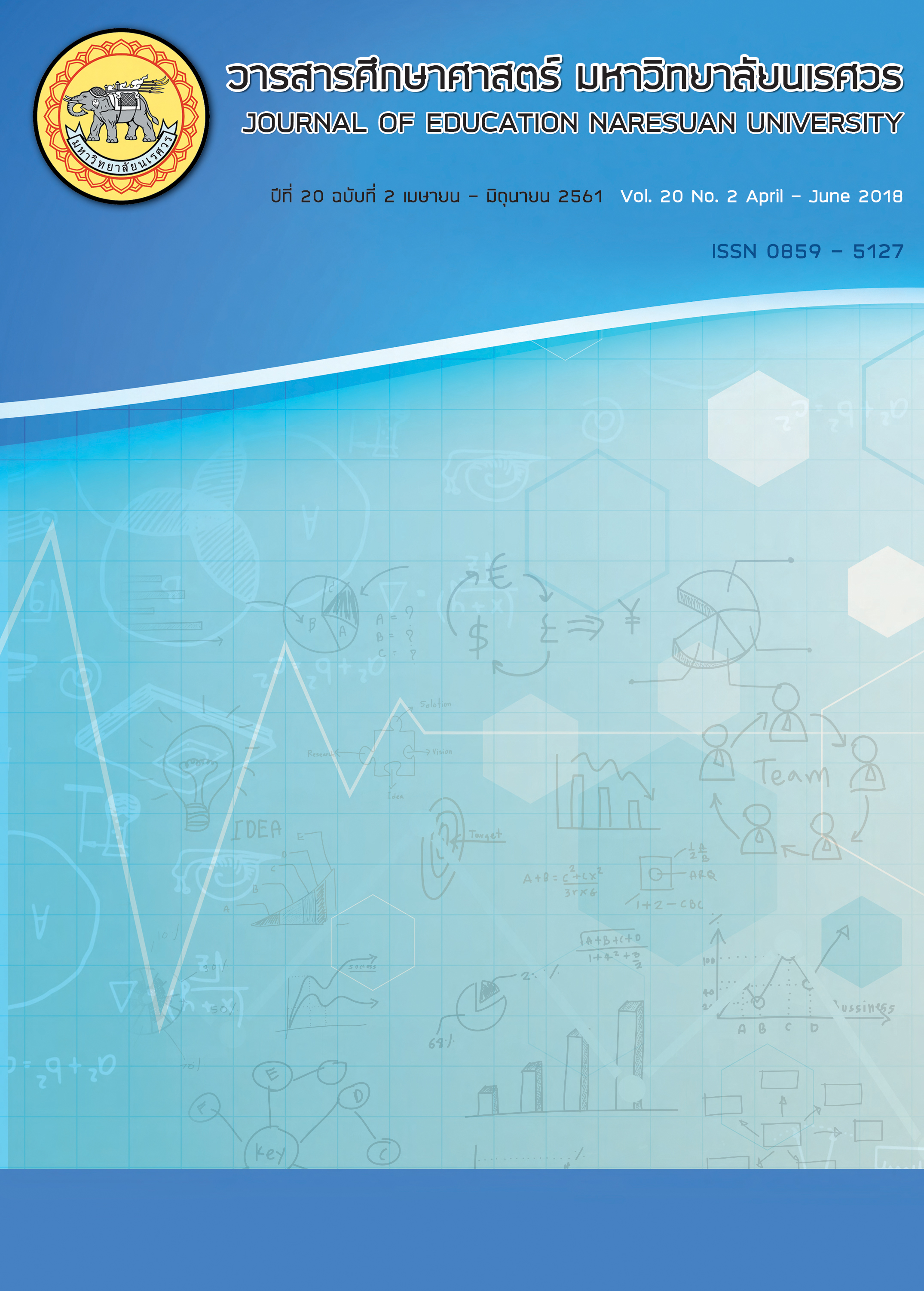ผลการจัดกิจกรรมการเรียนรู้แบบ PECA ร่วมกับโปรแกรมควิปเปอร์ สคูล เพื่อส่งเสริมความสามารถในการแก้โจทย์ปัญหาฟิสิกส์ของนักเรียน ระดับชั้นมัธยมศึกษาปีที่ 4; THE EFFECT OF PECA INSTRUCTIONAL ACTIVITIES TOGETHER WITH QUIPPER SCHOOL PROGRAM TO PROMOTE ...
Main Article Content
Abstract
การวิจัยครั้งนี้มีวัตถุประสงค์เพื่อ 1) เปรียบเทียบความสามารถในการแก้โจทย์ปัญหาฟิสิกส์ของนักเรียนระหว่างก่อนและหลังการทดลองด้วยกิจกรรมการเรียนรู้แบบ PECA ร่วมกับโปรแกรมควิปเปอร์ สคูล 2) เปรียบเทียบความสามารถในการแก้โจทย์ปัญหาฟิสิกส์ของนักเรียนหลังการทดลองด้วยกิจกรรมการเรียนรู้แบบ PECA ร่วมกับโปรแกรมควิปเปอร์ สคูล กับเกณฑ์ที่กำหนด ร้อยละ 60 กลุ่มตัวอย่างที่ใช้ในการวิจัยครั้งนี้เป็นนักเรียนมัธยมศึกษาชั้นปีที่ 4 โรงเรียนสาธิตมหาวิทยาลัยศรีนครินทรวิโรฒ ประสานมิตร (ฝ่ายมัธยม) กรุงเทพมหานคร ซึ่งได้มาโดยการสุ่มแบบกลุ่ม จำนวน 41 คน เครื่องมือที่ใช้ในการวิจัยประกอบด้วย แผนการจัด การเรียนรู้ กิจกรรมการเรียนรู้แบบ PECA ร่วมกับโปรแกรมควิปเปอร์ สคูล และแบบทดสอบวัดความสามารถในการแก้โจทย์ปัญหาฟิสิกส์ การวิเคราะห์ข้อมูลใช้ ค่าเฉลี่ย ส่วนเบี่ยงเบนมาตรฐานและสถิติ t-test ผลการวิจัย พบว่า
1. นักเรียนที่เรียนด้วยกิจกรรมการเรียนรู้แบบPECA ร่วมกับโปรแกรมควิปเปอร์ สคูล มีความสามารถในการแก้โจทย์ปัญหาฟิสิกส์หลังการทดลองสูงกว่าก่อนการทดลองอย่างมีนัยสำคัญทางสถิติที่ระดับ .05
2. นักเรียนที่เรียนด้วยกิจกรรมการเรียนรู้แบบPECA ร่วมกับโปรแกรมควิปเปอร์ สคูล มีค่าคะแนนเฉลี่ยความสามารถในการแก้โจทย์ปัญหาฟิสิกส์สูงกว่าเกณฑ์ที่กำหนด ร้อยละ 60 อย่างมีนัยสำคัญทางสถิติที่ระดับ .05
THE EFFECT OF PECA INSTRUCTIONAL ACTIVITIES TOGETHER WITH QUIPPER SCHOOL PROGRAM TO PROMOTE PHYSICS PROBLEMS SOLVING ABILITY OF MATTHAYOMSUKSA IV STUDENTS
The purposes of this research were: 1) to compare the students’ physics problem solving ability pretest-posttest of samples, 2) to compare the post-learning physics problem solving ability to the passing criterion of 60 percent. The respondents were 41 students in Mathayonmsuksa IV, Srinakharinwirot University Prasarnmit Demonstration School, Bangkok, sampled by Cluster random sampling. The research instruments were 1) a study plan based on PECA instructional activities together with quipper school program, and 2) the physics problem solving test. Statistical analysis employed were mean, standard deviation, and t-test. The research findings are as follows:
1. The posttest score on physics problem solving ability of the experimental group was higher than of the pretest at the .05 level of statistical significance.
2. The post-learning physics problem solving ability was higher than the passing criterion of 60 percent at the .05 level of statistical significance.
Article Details
The owner of the article does not copy or violate any of its copyright. If any copyright infringement occurs or prosecution, in any case, the Editorial Board is not involved in all the rights to the owner of the article to be performed.
References
Chitradub, S. (2011). Education reform miss Thailand's lack of teachers O-NET scores low. Retrieved July 29, 2016, from https://www.tlcthai.com/webboard/view_topic.php?table_id=1&cate (in Thai)
Ding, N., & Harskamp, E. (2007). Structured collaboration versus individual learning in solving physics problems. International Journal of Science Education, 28(14), 1669-1688.
Gaighera, E., Roganb, J. M., & Brauna, M. W. (2007). Exploring the development of Conceptual Understanding through Structured Problem solving in Physics. International Journal of Science Education, 29(9), 1089–1110.
Heller, K., & Heller, P. (2000). The competent problem solver for introductory physics. New York: Primis Custom Publishing.
Institute for the Promotion of Teaching Science and Technology. (2011). How to teach physics to understand. IPST Journal, 39(172), 40-43. (in Thai)
Khemmani, T. (2016). The pedagogy: A body of knowledge to the effective learning process. (20th ed.). Bangkok: Chulalongkorn University Press. (in Thai)
Moonkham, S., & Moonkham, O. (2002). 21 learning approaches for developing knowledge and skills. Bangkok: Pabpim Publishing. (in Thai)
National Institute of Educational Testing Service (Public Organization). (2016). Results of the Test of 9 Subjects in 2016. Retrieved February 11, 2016, from https://www.niets.or.th/th/catalog/view/247 (in Thai)
Portoles, J. S., & Lopez, V. S. (2008). Types of knowledge and their relation to problem solving in science: Direction for practice. Education Science Journal, 6, 105-112.
Quipper School. (2016). A Handbook for Quipper School. Retrieved April 28, 2016, from https://thailand.quipperschool.com/ (in Thai)
Rittidech, U. (2011). Ability in physics word problem solving of Mathayom Suksa Four students through Heller and Heller Logical problem-solving strategy (Master thesis). Chiang Mai: Chiang Mai University. (in Thai)
Rojas, S. (2010). On the Teaching and Learning of Physics Problem Solving. Rev. Mex. F´ıs, 56(1), 22–28.
Saksuparb, K. (2013). Development of an Instructional Model (PECA) with Emphasis on Physics Problems Solving Ability of Upper Secondary Students (Doctoral dissertation). Bangkok: Srinakharinwirot University. (in Thai)
Siripankaew, P. (1998). Teaching science student centered learning. IPST Journal, 26(103), 8-10. (in Thai)
Theppawan, P. (2011). Strategic human resource management: concepts and strategies for competitive advantage. Bangkok: Se-ed Press. (in Thai)


